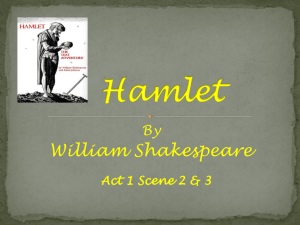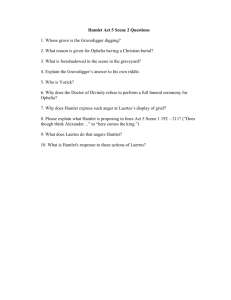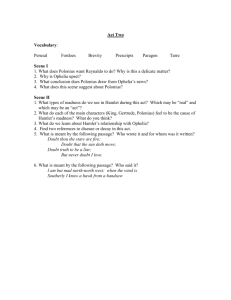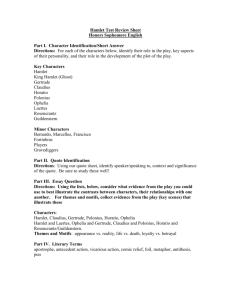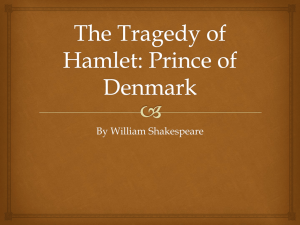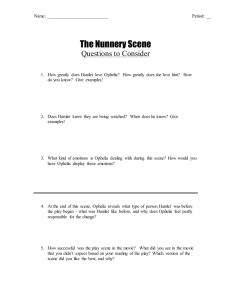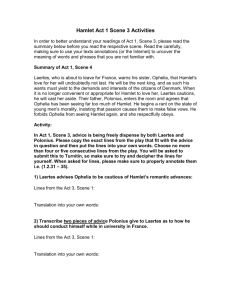1.3, 1.4 & 1.5 - Annotation Guide
advertisement
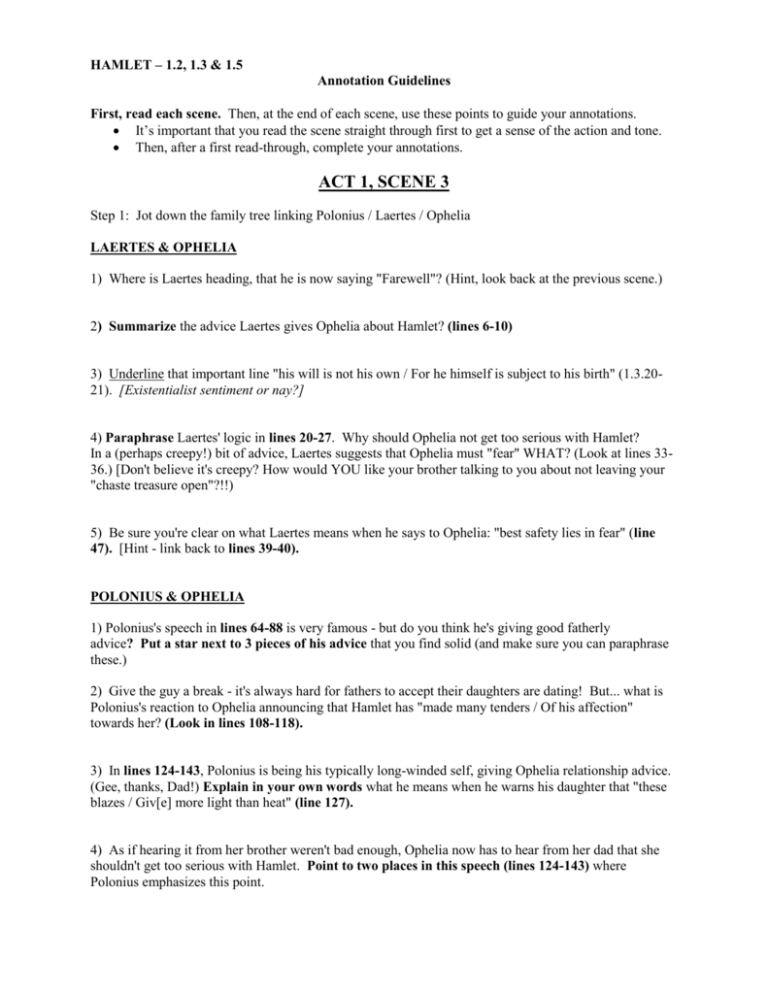
HAMLET – 1.2, 1.3 & 1.5 Annotation Guidelines First, read each scene. Then, at the end of each scene, use these points to guide your annotations. It’s important that you read the scene straight through first to get a sense of the action and tone. Then, after a first read-through, complete your annotations. ACT 1, SCENE 3 Step 1: Jot down the family tree linking Polonius / Laertes / Ophelia LAERTES & OPHELIA 1) Where is Laertes heading, that he is now saying "Farewell"? (Hint, look back at the previous scene.) 2) Summarize the advice Laertes gives Ophelia about Hamlet? (lines 6-10) 3) Underline that important line "his will is not his own / For he himself is subject to his birth" (1.3.2021). [Existentialist sentiment or nay?] 4) Paraphrase Laertes' logic in lines 20-27. Why should Ophelia not get too serious with Hamlet? In a (perhaps creepy!) bit of advice, Laertes suggests that Ophelia must "fear" WHAT? (Look at lines 3336.) [Don't believe it's creepy? How would YOU like your brother talking to you about not leaving your "chaste treasure open"?!!) 5) Be sure you're clear on what Laertes means when he says to Ophelia: "best safety lies in fear" (line 47). [Hint - link back to lines 39-40). POLONIUS & OPHELIA 1) Polonius's speech in lines 64-88 is very famous - but do you think he's giving good fatherly advice? Put a star next to 3 pieces of his advice that you find solid (and make sure you can paraphrase these.) 2) Give the guy a break - it's always hard for fathers to accept their daughters are dating! But... what is Polonius's reaction to Ophelia announcing that Hamlet has "made many tenders / Of his affection" towards her? (Look in lines 108-118). 3) In lines 124-143, Polonius is being his typically long-winded self, giving Ophelia relationship advice. (Gee, thanks, Dad!) Explain in your own words what he means when he warns his daughter that "these blazes / Giv[e] more light than heat" (line 127). 4) As if hearing it from her brother weren't bad enough, Ophelia now has to hear from her dad that she shouldn't get too serious with Hamlet. Point to two places in this speech (lines 124-143) where Polonius emphasizes this point. ACT 1, SCENE 4 1) We know why Hamlet would be annoyed with all the revelry going on, especially when he's feeling so upset. But why else does he get frustrated with his countrymen's celebrations? Paraphrase two of his arguments between lines 16-26. 2) Which lines in Hamlet's speech (between 26-40) seem to link to existentialist concepts? 3) (Guess who's back? Back again?) Re-read lines 50-56. What does Hamlet mean when he says that the "sepulcher / Wherein we saw thee quietly interred, / Hath oped his ponderous and marble jaws"? How does the use of personification make this image more dramatic? 4) Between lines 72-76, which lines most closely connect to Hamlet's first soliloquy when he wishes that his "too, too sullied flesh would melt"? 5) Hamlet uses the allusion to the Nemean lion in line 93 to emphasize. . . ACT 1, SCENE 5 HAMLET & GHOST OF KING HAMLET Handy reminder: "List" in this context means "Listen"! 1) What instructions does the Ghost give Hamlet? (Hint: It's between lines 30-35). 2) Highlight this: "The serpent that did sting thy father's life / Now wears his crown" (line 46-47.) Make sure you understand exactly how this statement by the ghost is true! (Re-read lines 66-87.) 3) What opinion does the Ghost have of Claudius? Look between lines 55-60 & find the specific line. 4) What 'call to action' does the Ghost insist upon for Hamlet? Highlight the key lines! (Find them between 85-100.) 5) Who is the "pernicious" woman? (What does pernicious mean)? (line 112) 6) After commiserating with his friend Horatio, Hamlet starts to make a plan. Underline the lines between 185-200 that most clearly explain what Hamlet is planning to do. 7) What is Hamlet's "curse". (Look at his final lines in the act and underline what points to the ‘curse’.)
